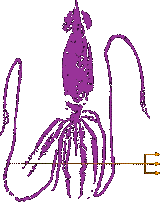


Certain creatures have the amazing ability to change the shape,
color and even texture of their skin at will. Octopuses are one of the best known examples of this adaptive ability.
They can alter their skin to mimic several different kinds of environments. They arenít just limited to one,
such as the stonefish.
Scientists have longed for the day they could create man-made technology that
does the same thing. Todayís news doesnít come anywhere near the ability of an octopus, but itís a solid step towards that.
Scientists led by Cunjiang Yu (University of Houston) and John Rogers
(University of Illinois at Urbana-Champaign) have developed a flexible sheet that detects incoming light and
changes its pattern to match. Right now, itís limited to changing from black to white and vice versa.
While it wonít be tricking anyone anytime soon, it does change colors quickly. Not the near instantaneous reaction
of an octopus, but within a second or so.
How does this man-made example work? Like an octopus skin, it contains three layers.
The top layer has a heat-sensitive dye that changes the skinís color from black at room temperature to colorless
at 47 degrees Celsius (116.6 Fahrenheit). The second layer is a thin piece of silver and creates the white background.
And finally, the third layer contains a diode used for heating the dye and controlling the color.
Incoming light tells the diodes to heat up the illuminated panels. This causes the dye
to become colorless revealing the bright white background of the second layer. Check out the video below to see it in action.
ďThere are analogies between layers of our system and those in the cephalopod skin,
but all the actual function is achieved in radically different ways,Ē says Rogers according to National Geographic.
ďThe multi-layer architecture works really well, though. Evolution reached the same conclusion.Ē
ďThe most exciting thing about this is that itís all automatic, without any external
user input,Ē he adds.
The most obvious applications are military. The scientists work was funded by the
Office of Naval Research. You could also imagine applications tied to homes. An adaptive material that reacts to,
certain lighting conditions would be handy. Iíll take curtains that keep my room pitch black until noon, please.



